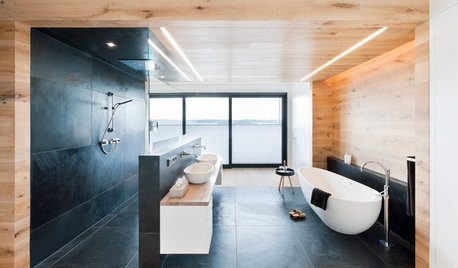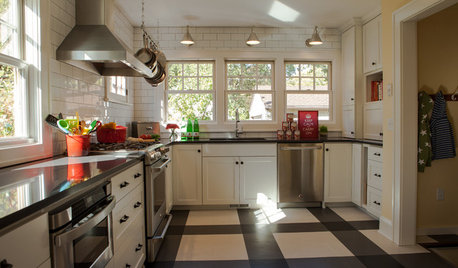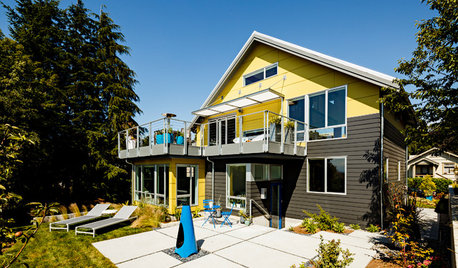Does Radiant Floor Heating make sense?
doctj
16 years ago
Featured Answer
Sort by:Oldest
Comments (28)
montalvo
16 years agobdpeck-charlotte
16 years agoRelated Discussions
Is radiant floor heat adequate as the only heat source?
Comments (7)Thanks for all the input; it's been really helpful. Shanghaimom, I did a 'step test' with a 12x12 marble sample I had on hand, and you're right; it is so much colder than the tile. That has convinced me to install floor heat, even if it's only a secondary source. I had no idea that hydronic toekick heaters existed; the quotes I got all mentioned 'electric fan toekick heaters', and I didn't want to go that route. When discussing with my contractor last evening, he was very supportive of the hydronic solution; now I just have to make sure that the unit will fit under the 'door' side of my vanity (will need to access it for service, so it really shouldn't creep into the drawer side of the cabinet.) Fingers crossed! Mongo, thanks! I'll do my homework on the BTU calculations; thanks for pointing out what to look for. Lynneblack, thanks for the vent/fan/light combo idea. I've read on the boards that the Panasonic is a great unit, but one of the two items I'm keeping from the current bathroom is my Nutone melon vent fan/dimmable light....See MoreRadiant Flooring-Does it heat the room?
Comments (6)To different animals to consider, Hydronic radiant versus baseboard, in terms of the water temp they circulate. With true hydronic radiant, you want to circulate water that is around 110-120 degrees. The goal is for the finished flooring surface to not exceed around 80-85 degrees. The problem with converting baseboard to radiant hydronic is that baseboard systems typically circulate 180-degree water. Running water that hot through a tight hydronic floor system can result in thermal expansion and contraction issues with the floor. For best performance, it usually results in having to put a the hydronic loop on it's own circuit separate from the the baseboard water. There are a few ways that can be accomplished. You might be able to get away with circulating 180-degree water if you did something like a below-floor suspended PEX system in the joist bays. Not "staple up" with transfer plates, but simply suspending the loop a few inches below the subfloor. For 180-degree temps, I'd prefer to use copper over PEX. But that's a whole new thread in and of itself. If the room is well insulated, or has no exterior walls, in-floor electric mats can provide enough BTUs to heat the room space. You'd need to consider the BTUs per sqft that those systems provide. An alternative would be in-floor electric for simple floor comfort warming, and something along the lines of a Runtal electric or hydronic Omnipanel for room heating. The Omnipanel can put out enough BTUs to heat a room....See MoreWhat does DIY radiant floor heat cost and would you do it?
Comments (2)Thanks weedyacres! I actually found the older thread on this exact topic and I'm now convinced that if there's any way we can afford it, we should do it. The problem is that we hadn't budgeted for this bathroom reno at all this year, but the leak & subsequent major mold problem necessitated ripping out the floor, vanity and shower, so now we're forced to renovate the bath now or live without it. It's a major bummer because I had wanted to really do this "right", since its the master bath. On top of that we have a 2/3 finished kitchen that we were in the middle of renovating and we wont be able to afford to finish that for a while either, because of this emergency!! Sheesh. At least I have appliances now. I can live without a backsplash for a while! Anyway, please email me about your leftover materials. If I can convince DH on this, I'd be very interested in talking to you about cost and logistics. Thanks for the offer....See MoreDoes radiant floor heat cause grout issues?
Comments (8)julie, yes and no. If it's done correctly, you don't need Ditra. But Ditra can absorb some sins. But if the mesh still isn't filled with thinset and then it's covered with Ditra, problems could still occur. Like most areas of employment, there's a fair amount of ignorance and apathy in construction. Sometimes it doesn't affect things, other times it can cause problems. Faster and cheaper often takes longer and costs more....See MoreRon Natalie
16 years agomontalvo
16 years agoarmomto3boys
16 years agomontalvo
16 years agomontalvo
16 years agobarbcollins
16 years agomsm859
16 years agodestynee
16 years agoworthy
16 years agonacnac
16 years agoRon Natalie
16 years agotdegen
16 years agosierraeast
16 years agodoctj
16 years agomeldy_nva
16 years agotdegen
16 years agodoctj
16 years agomikeyvon
16 years agobdpeck-charlotte
16 years agobuzzsaw
16 years agotruzella
15 years agoRon Natalie
15 years agoschreibdave
15 years agogopintos
15 years agoRon Natalie
15 years ago
Related Stories

FLOORSIs Radiant Heating or Cooling Right for You?
Questions to ask before you go for one of these temperature systems in your floors or walls (yes, walls)
Full Story
FLOORSFloors Warm Up to Radiant Heat
Toasty toes and money saved are just two benefits of radiant heat under your concrete, wood or tile floors
Full Story
GREAT HOME PROJECTSHow to Add a Radiant Heat System
Enjoy comfy, consistent temperatures and maybe even energy savings with hydronic heating and cooling
Full Story
MOST POPULAR5 Remodels That Make Good Resale Value Sense — and 5 That Don’t
Find out which projects offer the best return on your investment dollars
Full Story
INSIDE HOUZZHow Much Does a Remodel Cost, and How Long Does It Take?
The 2016 Houzz & Home survey asked 120,000 Houzzers about their renovation projects. Here’s what they said
Full Story
FLOORSWhat to Ask When Considering Heated Floors
These questions can help you decide if radiant floor heating is right for you — and what your options are
Full Story
BATHROOM DESIGNDream Spaces: Spa-Worthy Showers to Refresh the Senses
In these fantasy baths, open designs let in natural light and views, and intriguing materials create drama
Full Story
KITCHEN DESIGNKitchen of the Week: Drab and Dysfunctional to Radiant in Minnesota
Clunky storage and lackluster floors get nixed in favor of open shelves, plaid vinyl and an effective kitchen work triangle
Full Story
GREEN BUILDING5 Common-Sense Ways to Get a Greener Home Design
You don't need fancy systems or elaborate schemes to make your home energy efficient and sustainable. You just need to choose wisely
Full Story
BATHROOM DESIGNWarm Up Your Bathroom With Heated Floors
If your bathroom floor is leaving you cold, try warming up to an electric heating system
Full Story






armomto3boys